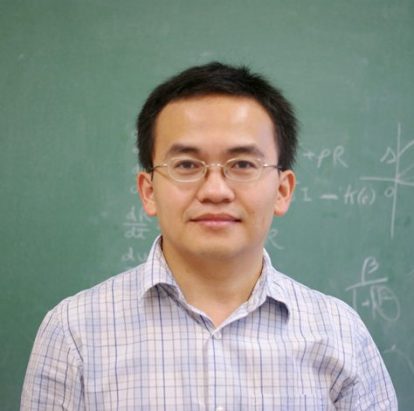UF professor uses mathematical models to explain viral dynamics and drug resistance.
There are six major genotypes of Hepatitis C infections. In the U.S., 70 percent of cases are caused by genotype 1. In an infected person, about 1012 virus particles are produced each day. There is no vaccine, but chronic infection can be cured 95 percent of the time with new anti-viral medications. Having so many numbers to wrangle, UF applied mathematician Libin Rong is eager to tackle the problems facing healthcare providers, pharmaceutical developers, and epidemiologists. How quickly do viruses reproduce, and how does that rate change after drug treatment? How much drug treatment is needed to be effective?
Rong was born in a small village in China, where he became interested in math at a young age. He went to college in Shanghai to study pure mathematics, but he soon delved into the applied realm by modeling neural networks for artificial intelligence. In a postdoc position in mathematical biology at Los Alamos National Laboratory, he shifted further toward a fusion of the natural and mathematical sciences. Intrigued by the many collaborative opportunities at UF, he left his previous position at Oakland University to join UF’s Department of Mathematics and work with researchers at UF’s College of Medicine and the Emerging Pathogens Institute. He also is thrilled to have a large pool of graduate students from which to choose as his mentees. “I enjoy supervising students,” he says.

Rong develops mathematical models to predict the numbers of diseases at each point: spread among a population, infection and onset of symptoms, response to drugs, and emergence of drug resistance. “We use differential equation systems to describe a biological process, then we compare the modeling projection with the real data” — which he obtains from colleagues in health sciences — “so that we can determine or test different mechanisms underlying those biological data. We can also quantify the drug effectiveness,” he says.
Recently, Rong has been focusing on Hepatitis C. “A lot of drugs have become available, but the virus can mutate, and if a drug is used as a mono-therapy — if we just use one drug — drug resistance can emerge very quickly,” says Rong. “I developed a mathematical model to explain why drug resistance is expected so rapidly after the mono-therapy, and then to estimate how many drugs would be needed to overcome the resistance.” Currently, he is collaborating with researchers at UF’s medical school to determine which combination of drugs is an optimal therapy for Hepatitis C. He also is looking at how Hepatitis C treatments might apply to Chikungunya, a mosquito-borne disease with no approved drug therapies.
Rong’s other primary focus is HIV. Particular characteristics of HIV make its eradication challenging. In particular, latent reservoirs of the virus can reemerge after years of treatment, even after the initial dormancy period. “We don’t know why this pool is so stable even after continuous therapy for many years,” he says. Patients experience “blips,” or temporary surges in the viral load (the amount of virus in the blood). Whether the blip is just a blip, or a sign of failing treatment or drug resistance, can be addressed through mathematical modeling. “We proposed a few mechanisms to try to explain this blip and the stability of the latent reservoir, and we have one mechanism confirmed by data,” Rong says. With continued collaborations among UF’s colleges, Rong hopes that a solution can be found.
